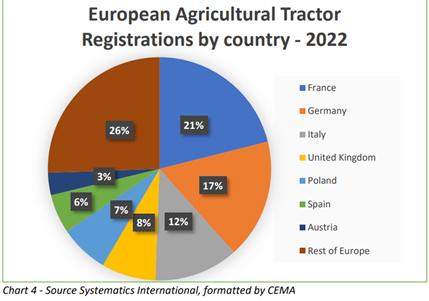Anticipated to achieve a CAGR of approximately 3.5% (2022-2027), the UK's agricultural equipment market expanded between 2014 and 2018, yet faced a significant downturn in 2019-2020 due to COVID-19.
STORY OUTLINE
- The investment landscape in the UK agricultural equipment market is diverse, offering a spectrum of opportunities from established manufacturers to startups driving disruptive change.
- Investors can benefit from the technological prowess of leading manufacturers like John Deere, CNH Industrial, and AGCO Corporation as they drive the adoption of precision agriculture tools.
- Sustainability-minded investors can align their portfolios with companies like Fendt and New Holland, who are leading the way in eco-friendly equipment. Moreover, suppliers like JCB, closely aligned with government initiatives, offer a compelling investment avenue.
- Investors seeking novel solutions can explore startups and niche players like Hands Free Hectare, which demonstrate the potential for innovative disruption in the sector.
The UK agricultural equipment market is undergoing a transformative shift, driven by technological advancements, sustainability imperatives, and changing consumer demands. This article delves into the investment landscape within this dynamic sector, focusing on key players and the opportunities they offer to investors seeking to capitalize on the future of agriculture.
1. Leading Manufacturers' Technological Advancements

Prominent agricultural equipment manufacturers are at the forefront of innovation, investing significantly in cutting-edge technologies. Companies such as John Deere, CNH Industrial (parent company of Case IH and New Holland), and AGCO Corporation (including brands like Massey Ferguson and Fendt) are embracing precision agriculture solutions.
These players are developing GPS-guided tractors, sensor-driven machinery, and data analytics platforms. Investors who recognize the innovation potential of these manufacturers can tap into their market dominance and benefit from the growing demand for high-tech farming solutions.
2. Sustainable Leaders: Investing in Eco-Friendly Equipment
With the UK's commitment to achieving net-zero carbon emissions, investors are increasingly turning their attention to companies specializing in sustainable agricultural equipment. AGCO's Fendt.
For instance, offers electric tractors, while CNH Industrial's New Holland focuses on sustainable machinery design. Investing in these forward-thinking manufacturers aligns with both environmental goals and future market trends, as sustainable solutions gain momentum.
3. Government-Backed Initiatives and Suppliers
Government incentives play a pivotal role in shaping the investment landscape. Companies that provide equipment in line with government policies and support sustainable practices stand to benefit from these initiatives. A prime example is JCB, a UK-based construction and agricultural equipment manufacturer.
JCB's commitment to innovation and sustainability positions it well for government contracts and grants, making it an attractive investment option.
4. Startups and Niche Players

Get the Sample Report on UK Agri Equipment Market Players
The changing landscape of collaborative ownership models has given rise to startups and niche players offering specialized solutions for the agricultural equipment market.
Startups like Hands Free Hectare, known for developing autonomous farming solutions, showcase the potential for disruptive innovation.
Investors who identify emerging players catering to specific niches can tap into innovative solutions that address unique challenges in the farming sector.
In conclusion, the UK agricultural equipment investment landscape is evolving rapidly, presenting opportunities that cater to a range of investment strategies. As the sector advances with technology and sustainability at its core, investors who strategically align their portfolios with key players and emerging trends can navigate this landscape to capitalize on a promising future for agricultural equipment innovation and growth.




























